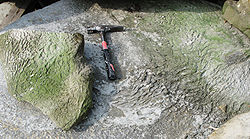- Microbially induced sedimentary structure
-
 This wrinkled "elephant skin" texture is a trace fossil of a non-stromatolite microbial mat.
This wrinkled "elephant skin" texture is a trace fossil of a non-stromatolite microbial mat.
The image shows the location, in the Burgsvik beds of Sweden, where the texture was first identified as evidence of a microbial mat.[1]Microbially induced sedimentary structures (MISS) are primary sedimentary structures formed by the interaction of microbes with sediment and physical agents of erosion, deposition, transportation, or deformation traces of microbial activity [2][3]. The structures commonly form when microbial mats (which may comprise bacteria, fungi, protozoans, archea or algae), or evidence thereof, are preserved in the sedimentary geological record[4]. MISS include stromatolites, wrinkle marks (sometimes described as an elephant-skin texture), microbial mat chips, mat curls, gas domes, and a variety of other forms.
Although these structures have only recently been named and systematically described, links between microbes and distinctive structures in sediments and sedimentary rocks have been suggested by several early workers [1][5][6]. MISS have been identified in beds dating from the Archean to the recent.[7] In the Ediacaran period, they are often associated with the preservation of fossils of the Ediacara biota; subsequent to this point their prevalence declines as a result of the Agronomic revolution.[7]
A number of criteria have been proposed for recognising genuinely biological structures, and discriminating them from similar-looking features that can arise through geological processes. These relate to the extent of metamorphism to which the rocks have been subjected; their stratigraphic position with respect to sea-level; their depositional environment; their relationship to ancient hyraulics; and their texture.[4]
References
- ^ a b Manten, A. (1966). "Some problematic shallow-marine structures". Marine Geology 4 (3): 227–669. doi:10.1016/0025-3227(66)90023-5.
- ^ Noffke, N.; Gerdes, G.; Klenke, T.; Krumbein, W. E. (2001). "Microbially Induced Sedimentary Structures: A New Category within the Classification of Primary Sedimentary Structures". Journal of Sedimentary Research 71 (5): 649. Bibcode 2001JSedR..71..649N. doi:10.1306/2DC4095D-0E47-11D7-8643000102C1865D.
- ^ Noffke, N., 2003, Microbially induced sedimentary structures, in Middleton, G.V., ed., Encyclopedia of Sediments and Sedimentary Rocks: Boston, Kluwer Academic Publishers, p. 439-440.
- ^ a b Noffke, N. (2009). "The criteria for the biogeneicity of microbially induced sedimentary structures (MISS) in Archean and younger, sandy deposits". Earth-Science Reviews 96 (3): 173–180. Bibcode 2009ESRv...96..173N. doi:10.1016/j.earscirev.2008.08.002.
- ^ Riding, R. (2007). "The term stromatolite: towards an essential definition". Lethaia 32 (4): 321–330. doi:10.1111/j.1502-3931.1999.tb00550.x. http://www3.interscience.wiley.com/journal/119935443/abstract. }}
- ^ Pratt, B.R., 2003, Stromatolites, in Middleton, G.V., ed., Enyclopedia of Sediments and Sedimentary Rocks: Boston, Kluwer Academic Press, p. 688-690.
- ^ a b Callow, R. H. T.; Brasier, M. D. (2009). "Remarkable preservation of microbial mats in Neoproterozoic siliciclastic settings: Implications for Ediacaran taphonomic models". Earth-Science Reviews 96 (3): 207–219. Bibcode 2009ESRv...96..207C. doi:10.1016/j.earscirev.2009.07.002.
Categories:- Geology
- Sedimentary structures
- Geology stubs
- Paleontology stubs
Wikimedia Foundation. 2010.
